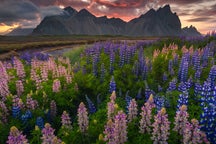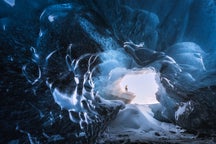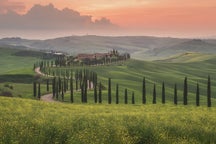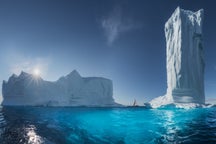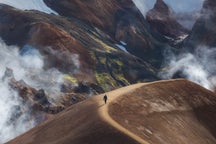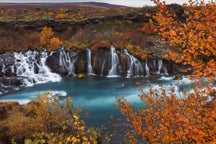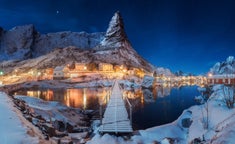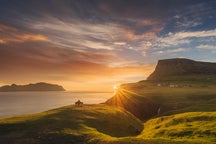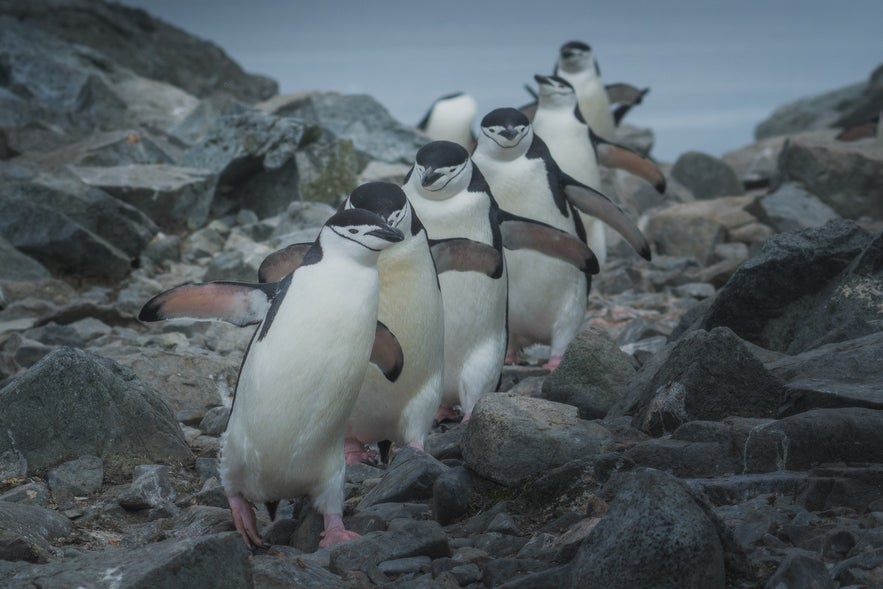
What is the best way to photograph penguins in Antarctica? What species of penguin live in Antarctica, and how are they different? Are there any tips, tricks and rules you need to know before setting out to catch them on camera? Continue reading for the ultimate guide to photographing penguins in Antarctica.
Every quality that penguins possess makes them photogenic; they are one of the most pleasurable and rewarding subjects to shoot in the animal kingdom. Their awkward, bumbling walk is endearing, their belly slides are adorable, their social interactions are heartwarming, and their emotive expressions are somewhat person-like.
 Gentoo penguins waddle on an Antarctic beach. Photo by: 'Daniel Kordan'.
Gentoo penguins waddle on an Antarctic beach. Photo by: 'Daniel Kordan'.
It is little wonder why they are regularly giving the starring roles in animated movies and documentaries, and why their cute behaviour often makes international news. The media stardom of penguins has brought environmental threats to the Antarctic to the world’s attention, refreshed a passion of wildlife programmes, and encouraged thousands to plan a trip to the world’s southernmost continent to witness and photograph them in their natural habitat.
While it is possible to book cruises and other trips that will give you the potential to see penguins in Antarctica, taking an Antarctic photo workshop is a far more immersive option and the closest you can get to a guarantee of multiple shoots of penguins.
For example, this twelve-day adventure, available in 2020 and 2021, will take you from the southern tip of South America to the southernmost continent on a modern, comfortable, specialised ship called the Gregg Mortimer. This ship has an art room for processing photos and the tour led by world-renowned, award-winning photographer Daniel Kordan, who will provide seminars and lessons on improving your skills and be on hand every shoot to help you get the perfect images.
- Check out this Interview with Daniel Kordan
 Visiting the Antarctic by ship is an exhilarating experience. Photo by: 'Daniel Kordan'.
Visiting the Antarctic by ship is an exhilarating experience. Photo by: 'Daniel Kordan'.
Not only this, but you’ll be joined by an expedition team who are experts on Antarctica's landscapes, the patterns of its wildlife, and how to safely navigate the terrain and interact with the animals. To make this workshop even more convenient, everything is arranged for you before your arrival, such as your hotels, meals and transfers, taking all the stress out of booking your adventure.
To photograph the penguins, you will visit the continent itself as well as some Antarctic and sub-Antarctic islands, by making day-trips on a zodiac. Because of the axis of the Earth in December and January, when this workshop takes place, the sun never sets in Antarctica, providing you with endlessly bright conditions and extended hours in which you can shoot.
The joy of photography tours such as these is that while you will have countless opportunities to photograph penguins exhibiting different behaviours in different environments, you will also be able to capture the other wonders of the Antarctic. This includes its spectacular land-, sea- and ice-scapes, as well as its other animals, such as its spectacular whales, its dramatic Elephant Seals and its diverse seabirds.
- Check out this Ultimate Guide to Wildlife Photography in Antarctica
 Whales, seals and penguins are the highlights of a photography tour to Antarctica. Photo by: 'Daniel Kordan'.
Whales, seals and penguins are the highlights of a photography tour to Antarctica. Photo by: 'Daniel Kordan'.
What to Bring for Photographing Penguins in the Antarctic
 Wildlife photographers in Antarctica's summer are blessed with seeing chicks. Photo by: 'Daniel Kordan'.
Wildlife photographers in Antarctica's summer are blessed with seeing chicks. Photo by: 'Daniel Kordan'.
Travellers to the Antarctic should, of course, prioritise bringing waterproof, windproof and very warm clothing to protect them from the elements; photographers, however, need to consider a host of other equipment. What lenses will be needed to capture the penguins? What accessories should be brought? What can help protect a camera from malfunctioning in the cold?
Largely, those interested in capturing spectacular images of Antarctica’s animals should bring similar equipment that they would on any wildlife shoot. A telephoto lens is nearly essential, allowing you to get intimate shots of penguins and other creatures without disturbing them; if it has a stabilising function, then all the better. This is particularly useful for shooting images of nests and chicks, which you will want to keep your distance from.
Considering penguin colonies are often vast, a wide-angle lens can help reveal how they become part of Antarctica’s stunning landscapes. Fish-eye lenses, meanwhile, can reveal the scale of a colony in a way that makes those looking at the photo feel like a part of it.
 Penguin colonies in Antarctica can number in the millions of individuals. Photo by: 'Daniel Kordan'.
Penguin colonies in Antarctica can number in the millions of individuals. Photo by: 'Daniel Kordan'.
In terms of accessories, extra batteries are vital; the cold drains their life incredibly quickly. External battery packs can be used as well if kept in a warm pocket. Tripods are optional; while they will help you frame your picture and ensure the stability of your camera while zooming, they can be cumbersome in Antarctic conditions. Any flash equipment is unnecessary, due to the light of the midnight sun, and unwanted, as it could disturb the animals.
When booking a trip such as the photo workshop mentioned, you’ll be provided with a list of all equipment you will need, as well as some suggestions for accessories and lenses that will add to your experience shooting penguins in Antarctica.
- Check out these Bright Ideas for Shooting in Daylight
Rules and Techniques for Photographing Penguins in the Antarctic
 Penguins in Antarctica's summer are often rearing chicks, so be cautious. Photo by: 'Daniel Kordan'.
Penguins in Antarctica's summer are often rearing chicks, so be cautious. Photo by: 'Daniel Kordan'.
The penguins of the Antarctic continent have evolved far from humankind, and their historical interactions with us have been extremely limited, only really beginning in the last century. As such, they have not learnt to fear us as predators like the vast majority of the rest of the animal kingdom has.
This placid nature makes photographing penguins in the Antarctic a delight, and will often provide even novices with some excellent additions to their portfolios. You can get relatively close without causing them to change their natural behaviours, allowing you to take candid pictures of them interacting with their chicks, scuffling for territory, or tossing their heads back and squawking to their peers.
In spite of their affable nature, there are, of course, precautions you must take when photographing penguins. Regulations dictate that you must not come within five metres of an individual for the following reasons.
 You must not come closer than five metres to a penguin in Antarctica. Photo by: 'Daniel Kordan'.
You must not come closer than five metres to a penguin in Antarctica. Photo by: 'Daniel Kordan'.
Firstly, most penguins in Antarctica in summer will either be raising eggs and chicks. You mustn't get anywhere near the nests, in case you should inadvertently step on one. This is a very real threat considering that you may have your eyes glued to your viewfinder. Your presence near a nest may also discourage parents from coming back to it in good time, which could lead to a chick starving or freezing.
Some penguins may even become aggressive if they feel like you are disturbing their chicks. Though they won’t do much damage through your thick clothing, it will still cause them to spend energy that could be better-used feeding or protecting their nests from real dangers such as seabirds. In the extreme conditions of the Antarctic, this could be the balance between life and death.
Secondly, they are likely to become at least agitated if you are nearby and they perceive you to be displaying threatening behaviour, such as making loud noises or making sudden movements. This is particularly the case considering many penguins are very near-sighted on land; as are social animals, if one becomes surprised and has a panicked reaction, it could set off a similar reaction throughout the colony.
 Penguin chicks in Antarctica are very vulnerable, so summer visitors must beware. Photo by: 'Daniel Kordan'.
Penguin chicks in Antarctica are very vulnerable, so summer visitors must beware. Photo by: 'Daniel Kordan'.
Such a panic could lead to birds abandoning their nests, fleeing to the water without taking precautions to avoid predators such as Leopard Seals, and may even discourage them from returning to the colony.
It should be noted that this five-metre rule is extended if the penguins move away from you; pursuing them would be a breach of regulation and an obvious encroachment on the animals in their natural environment.
The rule, however, only applies to you; if a penguin chooses to come closer, you do not have to move back. Many, particularly chicks, might be very curious of you and your camera equipment, allowing you to get some beautiful close-up shots and make fantastic memories that will last a lifetime.
It is important, however, not to touch the birds; their feathers contain oils essential for protection against the cold which you don’t want to displace.
 Penguins in Antarctica have little fear of people, and may approach curiously. Photo by: 'Daniel Kordan'.
Penguins in Antarctica have little fear of people, and may approach curiously. Photo by: 'Daniel Kordan'.
When photographing penguins, it is best to get low; not only does this make you seem less threatening, but provides a better angle for shooting them. It will also stabilise your camera if you chose not to bring a tripod, helping you focus when using a telephoto lens. It is also essential to be patient; some penguins may take a little while to get used to your presence.
It is possible to photograph penguins from the water, either from the shore or in a zodiac. Penguins do exhibit some interesting surface behaviour, such as breaching from water to land, or ‘porpoising’ to build up speed. However, they are only ever in the air momentarily, requiring a skilled photographer to snap them, making them much more difficult subjects. When bobbing on the surface of the water, they are also a challenge to shoot due to their black feathers blending in with the surrounding seas
If you are very sensitive to smell, then it’s recommended to bring something you can pinch your nose closed with when attending a colony; penguin guano reeks. Similarly, those sensitive to sound may wish to bring some earplugs, as the birds can be incredibly noisy.
- Check out the Complete Guide to Photographing Puffins in Iceland
How to Photograph Different Penguins in the Antarctic
 Different penguins must be shot using different techniques. Photo by: 'Daniel Kordan'.
Different penguins must be shot using different techniques. Photo by: 'Daniel Kordan'.
Eight species of penguin can be found in Antarctic and sub-Antarctic waters and landmasses:
-
The Emperor Penguin
-
The Adélie Penguin
-
The Chinstrap Penguin
-
The Macaroni Penguin
-
The Gentoo Penguin
-
The Southern Rockhopper Penguin
-
The Magellanic Penguin
The first five of these species live on the continent itself (the first two being endemic to it), and specific techniques on photographing each of them are discussed below.
Photographing Emperor Penguins
Emperor Penguins are the unquestionable stars of the Antarctic, the largest species of penguin at over a metre tall. Their person-like stature and expressions, deep parental bonds, and amazing ability to survive exclusively on the world’s most unforgiving continent have provided them with worldwide recognition and the featuring roles in countless documentaries.
Many people coming to the Antarctic with the ambition of adding some spectacular images to their portfolio do so largely because of these beautiful birds.
Upon arrival, few are not disappointed; Emperor Penguins make for magnificent subjects. Though more statuesque and beautiful than others of their kind, they retain the bumbling, clumsy nature that makes all penguins so endearing. Emperor Penguins are usually rather indifferent to the presence of people, and because of their size, the five-metre-rule does not impede shooting them.
Emperor Penguins are unique on this list as they are the only species that lay their eggs and rear their chicks over winter. You will not, therefore, be capturing interactions between parents and their offspring, but photographing adult birds preparing to summer out at sea and juveniles building up to their first departure from the colony.
Please note that if coming in later January, many Emperor Penguins will have already left.
Getting on your knees will put you at eye level with these creatures, allowing you to use your telephoto lens to take photos from the perspective of an Emperor Penguin; an even lower angle can be used to emphasise their height. Because Emperor Penguins gather in groups of hundreds of individuals, ensure you also bring a wide-angle lens to capture the scales of the colony in respect to the dramatic surrounding landscapes.
Photographing Adelie Penguins
 Adelie Penguins are Antarctica's most curious penguin. Photo by: 'Daniel Kordan'.
Adelie Penguins are Antarctica's most curious penguin. Photo by: 'Daniel Kordan'.
A kind person may describe Adélie Penguins as brave and curious; a bleaker person might simply describe them as stupid. Regardless, this species of penguin is remarkable for its fearlessness in the face of people and its eagerness to make new friends.
Several stories from early explorers note the bizarre behaviour of this bird, focusing on how they interacted with the dogs that accompanied them. Seeing the penguins, the dogs barked and pulled at their chains, clearly eager to chase down such easy prey. Rather than fleeing from this aggression, the Adélie Penguins found it most fascinating and hurried over to the dogs as quickly as they could to see what the fuss was about. In one case, a man had to carry a penguin away, which showed its displeasure by squawking, pecking his legs and trying to get back to the dogs.
As such, Adélie Penguins can be a challenge to capture in a way that is likely to be new to most wildlife photographers; rather than having to wait for them to get into the frame, you’re more than likely to have to wait for them to get out of it. You and your camera equipment may very well stimulate the birds to come investigating.
 Adelie Penguins, endemic to Antarctica, have noticeably dark beaks. Photo by: 'Daniel Kordan'.
Adelie Penguins, endemic to Antarctica, have noticeably dark beaks. Photo by: 'Daniel Kordan'.
Adélie Penguins don’t mean any harm, and so long as you treat them gently, you are unlikely to do any harm back. If they approach you, it would be wise to put your expensive equipment out of their reach, enjoy the experience, and wait for them to lose interest before resuming your photography. Of course, if you forgot your telephoto lens, this is a fantastic opportunity to get an intimate picture.
As your photography trip will occur during the breeding season of the Adélie Penguin, they may be less curious in you and more interested in looking after their young. Regardless, photographing a breeding colony of Adélie Penguins is an incredibly special opportunity considering the numbers that they gather in. Many colonies have half a million mating couples, and in 2018, an unfathomable one-and-a-half million pairs were present on the Danger Islands.
If you can catch Adélie Penguins leaping from the water onto the shore, as they routinely do to heights of up to three metres, it will make a spectacular action shot. Though difficult to time, a high shutter speed and burst function will help enormously. Due to the midnight sun, you don’t need to worry about not having enough light exposure between frames.
Photographing Chinstrap Penguins
 Chinstrap Penguins are adorable animals, found in Antarctica. Photo by: 'Daniel Kordan'.
Chinstrap Penguins are adorable animals, found in Antarctica. Photo by: 'Daniel Kordan'.
Adélie Penguins define themselves from their more indifferent cousins by being curious to a fault, but Chinstraps claim their uniqueness by being noticeably more aggressive. As likely as the former is to waddle over you for a nose into your camera bag, these birds may arbitrarily decide to stomp over mid-shoot and give you a pinch on the shin.
At around 70 centimetres tall and less than seven kilograms, Chinstrap Penguins don’t quite meet the definition of menacing, but if they get their beak or claws against your skin, it won’t be the most pleasant experience. The best way to avoid the fury of this angry little avians is to simply follow the guidelines above. Keep your distance, avoid their young, and move back if they are showing signs of discomfort. Failing this, try not to fear; you will survive the attack.
 Baby Chinstrap Penguins are guarded fiercely by their parents in Antarctica. Photo by: 'Daniel Kordan'.
Baby Chinstrap Penguins are guarded fiercely by their parents in Antarctica. Photo by: 'Daniel Kordan'.
Because of their confrontational nature, however, Chinstraps make for great subjects. It is not uncommon to see them squabbling on the beach, allowing you to get shots that reveal this unique trait and the behaviour it leads to. These fights can occur with different types of penguins, allowing you to bring an interspecies dynamic into your frame.
They are also unusual in their appearance, with a black stripe under their face making it appear like they are wearing a helmet, giving close-up shots with your telephoto lens some extra character.
Photographing Macaroni Penguins
Macaroni Penguins are also excellent subjects due to their appearance. As crested penguins, they have yellow feather tufts on their forehead that give the illusion of bushy eyebrows, which add even more personhood to this bipedal, sociable little character. This feature explains how they got their name; Macaroni was used in the 18th Century for fancy men who wore extravagant hats. Their tuxedo-like colouration and their swaggering walk further explain this comparison.
In terms of how their appearance impacts your photography, Macaronis are also larger than most other crested penguins such as Rockhoppers, making it easier to catch the details of their faces and expressions. This is especially the case considering that they are not only unafraid of people but notoriously short-sighted on land, allowing you to stand five metres without them even knowing.
Like Adélie Penguins, Macaronis gather in vast groups, though these tend to number in the tens of thousands, rather than the hundreds of thousands. Even so, they nest densely together in their colonies, allowing you to take landscape shots where it almost seems that the terrain is carpeted by endless nesting birds.
Macaronis are also some of the best penguins to photograph in the water, particularly from a zodiac, due to their yellow crests making them instantly identifiable and their ability to breach clear of the water when travelling at high speeds.
Photographing Gentoo Penguins
 Gentoo Penguins cooling on some Antarctic ice. Photo by: 'Daniel Kordan'.
Gentoo Penguins cooling on some Antarctic ice. Photo by: 'Daniel Kordan'.
The world’s third-largest penguin is the Gentoo. Gentoos make for wonderful subjects to their abundance, placidity and colouration. Their height and the white patches on this bird’s head make them easily identifiable, with the latter often being compared to a bonnet or turban. They also have long tails, unlike other species, adding to their uniqueness.
Unlike most other penguins, Gentoos form their colonies in a range of different areas; some prefer the snowy inland of Antarctica, others prefer rocky spaces where their eggs are better protected, while others remain in coastal regions. This allows you to capture them against a range of different backdrops utilising an array of different techniques, providing your portfolio with more diversity and stories of how penguins survive on this continent.
Gentoo Penguins during the summer are usually photographed in their lifelong breeding pairs. While many penguin species, contrary to popular belief, do not mate for life, Gentoos are one of the few that do. Images of their interactions and the interactions they have with their chicks are thus imbibed with a more human, emotive message than those of more fickle animal species. They provide a depth of character than many wildlife photographers strive to achieve in their photos.
 A Gentoo Penguin in Antarctica calls for its mate. Photo by: 'Daniel Kordan'.
A Gentoo Penguin in Antarctica calls for its mate. Photo by: 'Daniel Kordan'.
Gentoo Penguins can also be seen displaying some aggressive behaviours, providing a different angle to your documentation of them. Gentoo nests are surrounded by stones that are given to the females during courtship and are prized possessions. Female penguins will thus get aggressive if she feels another is eyeing up or getting too close to her stones, resulting in displays of strength and even physical struggles.
Gentoos will even force individuals out of their colony if they practice infidelity; capturing an animal being turned on by hundreds of its fellows would make for a dramatic image. Although such events are rarely seen, one of the wonders of wildlife photography in the Antarctic is that you never know what fascinating animal behaviours will unfold before you next.
Capture the behaviour of penguins as they frolic in their natural habitat in Antarctica! Join one of our Antarctica photography workshops for the experience of a lifetime.





